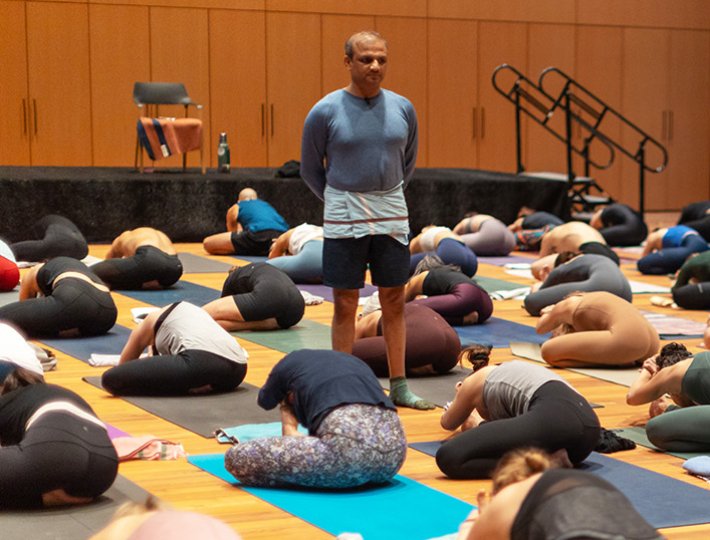In 1978, Michael Fox, then 21, accidentally ran a stop sign while stationed in Germany, and hit a two-ton garbage truck head on. He woke up in the hospital with a skull fracture and a crushed kneecap. It marked the beginning of a changed life.
Although Michael eventually recovered, he was left with agonizing chronic nerve pain in his left knee. Upon the advice of his doctors, he returned to his hometown of Ottawa, Canada to undergo several operations including a patellectomy, the removal of his entire kneecap. Staying active initially helped manage the nerve pain, but over time, it worsened. The constant discomfort affected his friendships, his marriage, his confidence in his doctors, and his faith in the divine.
“Pain is an excellent manipulator of emotion,” he says with perhaps a hint of a smile in the gentle tone of his voice. Even the smallest changes in temperature, like a walk down the frozen food aisle at the grocery store, tormented him. At night, when agony stole his sleep, he would roam the empty halls of the military quarters, where he once worked, in an effort to pass the time. He was given anti-depressants, but the meds didn’t help. He turned to alcohol to cope.
His doctor prescribed meditation as a last resort. Michael had heard of it before, but in the mid-80s, meditation was hardly mainstream.
“Hocus pocus,” he recalls thinking to himself. “Maybe some monk in Tibet can do meditation, but in North America?”
Michael was desperate, so he left the doctor’s office with a cassette tape in hand. Immediately, upon laying his head back in his favorite La-Z-Boy chair and closing his eyes, the soothing voice of meditation teacher Sylvie Lemelin began. The instructions coming through the headphones were clear and comforting. His breath started to naturally slow and become deeper. His thoughts softened and anchored. For 12 minutes, the techniques of autogenics, tension relaxation, and active progressive relaxation guided him into a whole new world. A world where his mind was no longer at war with his body, and where he no longer sought refuge from his own mind. Meditation was working.
Related: Can Mindfulness Really Reduce Pain?
Looking back, Michael credits Lemelin’s tape with saving his life. It transformed him, not only allowing him to manage the pain in his knee, but also making him less prone to bouts of anger, fear, and self-loathing that had long plagued him. Several years later, after undergoing full knee replacement surgery, he started yoga classes at a local studio at the urging of his daughters. It seemed to be the perfect companion to his meditation practice. He started taking classes daily, but felt something was missing.
“The classes were secular,” Michael says. “They had no room for the divine. No chanting, no meditation, no yamas, no niyamas.” Three years later, he came across the Ashtanga method via a Facebook friend and was hooked from the start at age 58. He was fascinated by the emphasis of Patanjali’s Eight Limbs within the Ashtanga method. He was also drawn to its grounding in lineage or parampara, where knowledge is passed on from teacher to student. “This wasn’t just exercise, it was poetry,” he says. “It was exactly the complement to meditation that I had been looking for—intense concentration and mindfulness in motion!”
This May, Michael, now age 61, met Sharath Jois, the grandson of Sri K. Pattabhi Jois and the current lineage holder, for the first time. Through Google searches and word of mouth, Michael had learned about Sharath and the Ashtanga lineage over the years, but attending Sharath’s three-city tour in the U.S., where he participated in all six primary series classes in New York City, was a completely new experience. He was blown away by the energy inside the gymnasium of the Chinatown YMCA, packed with students and teachers of all levels who had traveled from all over the world. They were here for the same reason: To study with their teacher and practice with their community. To Michael, this was a new kind of love, not only for the practice, but also for each other.
“When I watched the more advanced second series class practice, the devotion was evident,” Michael says. As a relatively new Ashtanga yoga student, it must have been overwhelming to join his new peers, who had been practicing for decades. He admits with a laugh that he went into it with the mindset to try his best. “I focused. I stayed in my practice and thought about being in the moment. Breathe, Bandha, Drishti. If something bothered me, I’d think about Ganesh and carry on,” he says.
Michael came to Ashtanga yoga much later in life, and his humility, sincerity, and sense of devotion to his practice is infectious. While the community welcomed him with open arms, he recognizes it isn’t always easy.
“Ashtanga has been nurturing, but not without its difficulties,” he explains. “When the chronic pain returns [as it often does], I realize that I need to get on my mat, breathe, and begin the chant in praise of my local teacher—Janice DeFilippi, owner of Astanga Yoga Ottawa—and my teacher’s teacher. Adversity has taught me a great deal.”










Comments (0)